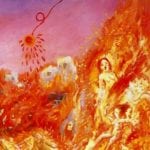 Crime
Crime  Crime
Crime  Technology
Technology 10 Hilariously Over-Engineered Solutions to Simple Problems
 Miscellaneous
Miscellaneous 10 Ironic News Stories Straight out of an Alanis Morissette Song
 Politics
Politics 10 Lesser-Known Far-Right Groups of the 21st Century
 History
History Ten Revealing Facts about Daily Domestic Life in the Old West
 Weird Stuff
Weird Stuff 10 Everyday Products Surprisingly Made by Inmates
 Movies and TV
Movies and TV 10 Actors Dragged out of Retirement for One Key Role
 Creepy
Creepy 10 Lesser-Known Shapeshifter Legends from Around the World
 Animals
Animals 10 Amazing Animal Tales from the Ancient World
 Gaming
Gaming 10 Game Characters Everyone Hated Playing
 Crime
Crime 10 Terrifying Serial Killers from Centuries Ago
 Technology
Technology 10 Hilariously Over-Engineered Solutions to Simple Problems
 Miscellaneous
Miscellaneous 10 Ironic News Stories Straight out of an Alanis Morissette Song
Who's Behind Listverse?

Jamie Frater
Head Editor
Jamie founded Listverse due to an insatiable desire to share fascinating, obscure, and bizarre facts. He has been a guest speaker on numerous national radio and television stations and is a five time published author.
More About Us Politics
Politics 10 Lesser-Known Far-Right Groups of the 21st Century
 History
History Ten Revealing Facts about Daily Domestic Life in the Old West
 Weird Stuff
Weird Stuff 10 Everyday Products Surprisingly Made by Inmates
 Movies and TV
Movies and TV 10 Actors Dragged out of Retirement for One Key Role
 Creepy
Creepy 10 Lesser-Known Shapeshifter Legends from Around the World
 Animals
Animals 10 Amazing Animal Tales from the Ancient World
 Gaming
Gaming 10 Game Characters Everyone Hated Playing
Top 10 Worst Years To Be Alive in Human History
We can all agree that 2020 was a pretty crappy year for a lot of people around the world, and 2021 wasn’t much better. However, while 2020–2021 were undoubtedly bad years for the people experiencing them, they are hardly the worst years in history.
Human history is filled with absolutely horrible years that saw natural disasters, wars, and other issues cause so much pain and chaos, it’s hard to imagine how humanity survived through them.
Sure, the pandemic is terrible, but the majority of people didn’t have to also endure a worldwide conflict, a far deadlier disease without medicine to treat it, or a global drop in temperature that destroyed the annual harvests. Those are the issues that make for a terrible year, and these ten (presented in no particular order because they all suck) are the worst.
Related: 10 Shocking Man-Made Disasters
10 536: Insane Changes in Global Weather Result in Widespread Starvation
The sixth century wasn’t a great time to be a human for several reasons that all came together to create a year that no time traveler would ever visit. Not only was 536 one of the worst years in history, but it also kicked off a decade of darkness, the likes of which haven’t been seen since.
The darkness was literal, thanks to the eruption of a volcano in Iceland. The resulting ash cloud created a fog of blackness that blanketed most of Europe. In addition, the eruption was so large, it affected global climate change, making it almost impossible to successfully grow crops. This resulted in widespread famine, pestilence, and death.
The Byzantine historian Procopius wrote that “the Sun gave forth its light without brightness, like the Moon during this whole year.” Another impact of the volcano was a lowering of summer temperatures by some 1.6–2.7°C (35–37°F), resulting in summer snow in China.
AD 536 kicked off the coldest decade recorded over the past 2,300 years. The year was truly the beginning of a dark era that lasted for most of the middle of the century. Subsequent volcanic eruptions, failed harvests, and the onset of the plague caused deaths all over the planet.[1]
9 1945: WWII Atomic Bombs, Incendiary Bombs & the Holocaust
There’s no denying that World War II was one of the darkest and deadliest conflicts in world history. More people died in that global conflict than in any other war. Any year the fighting raged on could be considered for this list, but 1945 takes the prize as the worst of them all.
WWII came to a bloody conclusion in ’45, and that victory came at a high cost. The U.S. dropped two atomic bombs on Japan, resulting in more than 400,000 casualties. On top of that, the firebombing of Tokyo saw 2,000 tons of incendiary bombs fall on the city, resulting in the deaths of between 80,000 and 130,000 civilians.
Beginning in 1943, the Nazis began to destroy as much evidence as possible that detailed the mass extermination of Jews and other populations. The Holocaust resulted in the deaths of approximately six million European Jews and millions of others. Toward the end, the Nazis increased exterminations to try and cover up their crimes.
The Second World War finally came to an end in mid-August of 1945, but the victory didn’t mean an end to global suffering. An estimated 3% of the worldwide population was dead, with an estimated death toll of between 70 and 85 million people. Reconstruction was difficult, and years of suffering followed in many parts of the world.[2]
8 1816: The Year Without a Summer
An ice age is defined as an extended period of glaciation, so we’re technically in one now. That said, most people think of an ice age as a time when the majority of the globe is covered by continental ice sheets. But another way to look at it is a year where the winter snow doesn’t melt—and that happened in 1816.
Many historians refer to 1816 as “The Year Without a Summer” due to the average decline in global temperatures. A drop of 0.4–0.7°C (0.7–1.2°F) may not sound like a big difference, but fluctuations in global temperature don’t need to be massive to cause serious problems. The temperature drop resulted from the Mount Tambora eruption the previous year.
That eruption occurred in what is now Indonesia, and it was the largest volcanic eruption in some 1,300 years, blanketing the planet with ash. The resulting volcanic winter caused “the last great subsistence crisis in the Western World,” affecting Western Europe and Eastern North America.
People experienced extreme frosts and snowfall in June, and rivers remained frozen well into August. The people affected by the changes in the weather saw no summer in 1816, and the resulting crop failures led to widespread famine and deaths across the northern hemisphere.[3]
7 1918: WWI & the Spanish Flu Pandemic
When WWI came to an end, what appeared to be the darkest time in humanity finally came to an end. Unfortunately, it wasn’t the end of suffering because the conflict’s conclusion brought forth disease and death that quickly swept across the world. The Spanish Flu was caused by the H1N1 Influenza A virus. Its first recorded case popped up in returning military members in Kansas in 1918.
The virus was believed to have been carried over to the United States via troops returning from the war, and it spread fast. Within two years of the first case, some 500 million people across the world were infected, which was nearly a third of the global population at the time.
The lethality of the Influenza strain was much different than the typical flu that spreads each year. Instead of killing the young, infirmed, and old, the Spanish Flu infected and killed an unprecedented number of young adults. This was due to the way it attacked the immune system. A person infected with H1N1 Influenza A would often succumb within 24 hours, making treatment incredibly difficult. Of course, it didn’t help that there wasn’t a treatment or flu vaccine.
The virus caused the most lethal flu pandemic to date, but it wasn’t simply the virus that was lethal. The combination of the virus and years of malnourishment, poor hygiene, and dozens of other factors brought on by the Great War ultimately resulted in the deadliest plague of the 20th century. When it was over, between 25 and 50 million people were dead.[4]
6 1929: The Stock Market Crash
The 20th century wasn’t easy for many people around the world. A lot of problems that weren’t related to wars and plagues centered around finances. On October 29, 1929, the world was stunned to see the U.S. stock market take a massive dive. Across the nation, people were left with nothing as factories, banks, and other institutions closed their doors.
The U.S. Stock Market Crash of ’29 came only a month after the London Stock Exchange crashed, obliterating two of the largest economies. Unfortunately, surviving Black Tuesday was only the beginning of an awful year because the rest of 1929 didn’t offer much in the way of improvement.
In fact, 1929 was simply the first year in many that saw the Great Depression completely devastate the U.S. economy and numerous economies around the world. Banks failed, and they took the peoples’ money with them. This was due to speculative banking investments in the stock market, and the banks used deposited money for this venture.
Once the banks failed, all that money was gone, leaving people without their life savings in an economy that remained in the red for the next decade. The world economies wouldn’t begin to recover until after WWII, though the U.S. economy wouldn’t fully recover until 1954.[5]
5 541: The Plague of Justinian
While most people know of the Black Death that swept across Europe in the 14th century, it wasn’t the first or only time the bubonic plague threatened humanity. The first recorded instance of the plague came in 541 during the reign of Emperor Justinian, and history knows him best because of a massive pandemic that took on his name.
The first recorded pandemic of the bubonic plague affected the Sassanian and Byzantine Empires. The latter was led by Emperor Justinian I. The emperor was infected but survived, which is one of the reasons the plague bears his name. The plague first hit Constantinople in 541. From there, it spread throughout the Mediterranean Sea, affecting many coastal cities.
It then made its way across Europe and into Asia. The first wave of the plague, the Plague of Justinian, lasted from 541 until 549, but it wasn’t the end. The contagion actually lasted for hundreds of years. This was a plague people had to live with, off and on, from one wave to another, for their entire lives. It didn’t come to an end until the mid-eighth century.
It’s difficult to estimate how many people died during the Plague of Justinian, though some numbers have been recorded. Constantinople suffered greatly from the pandemic, losing 55–60% of the population. Between five and ten thousand people died each day throughout the plague, which ultimately killed millions of people.[6]
4 1783: The Laki Volcanic Eruption
Volcanic eruptions always cause a great deal of disruption in their immediate area, but some affect a much larger area than others. Laki is a volcanic fissure in Iceland, and while it’s safe today, in 1783, it erupted violently. The fissure erupted for eight months, ending in February 1784 after an estimated 42 billion tons of hydrofluoric acid, sulfur dioxide, and basalt lava poured out.
When it erupted, it was explosive, but that didn’t last the whole eight months. After a few days, the lava flow continued, but without the volatile nature of its initial eruption. It became more like the Hawaiian eruptions that happen today, but the lava wasn’t really the problem.
For eight months, the fissure spewed sulfuric aerosols into the atmosphere, resulting in devastating climate change that impacted the rest of the world. Iceland suffered the most from a catastrophic famine. Nearly a quarter of the population died, as did more than half the cattle, horses, and sheep.
The eruption weakened the African and Indian monsoon seasons, resulting in a famine in Egypt and other locations. Europe suffered a deadly haze that lasted through the winter of 1784, and that’s just the beginning. Ultimately, the Laki volcanic eruption devastated the global climate and resulted in thousands of deaths.[7]
3 1520: Europeans Bring Diseases to the Americas
When Europeans made their way to the Americas en masse, they opened up new territories, increased trade, and brought deadly pathogens to the Indigenous population. The people of the Americas were generally isolated from the diseases that had been killing people in Europe, Asia, and Africa for millennia.
In 1520, Europeans brought smallpox to the Indigenous people of the Americas, and it did not go well. That is to say, it didn’t go well for the people living there, but it worked out splendidly for Europeans, seeing as it opened up two continents for colonial expansion. For the people of North, Central, and South America, it was an absolute catastrophe.
Without any means of fighting off smallpox, as many as 95% of all indigenous people perished in the years that followed its introduction. It’s difficult to say precisely how many people died from smallpox after it came to the Americas, but some estimates put the number as high as 20 million.
Before Columbus “discovered” the Americas in 1492, the estimated population of the continents was some 60 million people. That number dropped significantly due to the 1520 smallpox epidemic. It continued to decline via measles, influenza, diphtheria, and the bubonic plague to around only six million. This left the continents largely empty and open to European colonization.[8]
2 1347: The Black Death Spreads Across Europe
There’s no denying that the COVID-19 pandemic is terrible, but it pales in comparison to the Black Death. Beginning in 1346, the bubonic plague spread across Eurasia and North Africa, killing more people than any other pandemic in human history. The plague was first identified in Crimea in 1347, and from there, it spread like wildfire.
The plague is caused by a bacterium called Yersinia pestis, spread by fleas. In the 14th century, fleas were a much bigger problem than they are today, so the pestilence spread quickly. Unfortunately, it was also transmitted via person-to-person contact, making it hazardous to care for anyone stricken with the disease.
It’s difficult to pick a specific year as the very worst of the pandemic, as records aren’t as forthcoming with data as they would be today. The estimated death toll from the Black Death is between 75 and 200 million people over the course of eight years.
That makes the Black Death the most fatal pandemic ever recorded, and it had lasting impacts. When the plague finally ended in 1353, as much as 60% of the European population was dead. This left huge gaps in a largely agrarian society, making a recovery difficult and slow.[9]
1 73,000 BC: The Toba Catastrophe
The Toba catastrophe is a theorized supervolcanic eruption that took place some 75,000 years ago (+/- 900 years) in what is now Indonesia. The exact date is unknown, but research into human DNA and geologic evidence of the time suggests that a massive eruption caused the deaths of most of the human population at the time.
While it’s impossible to say exactly how many humans succumbed to the volcanic winter that lasted around a decade, scientists have come up with a number of how many survived. It’s believed that the human population was reduced to as little as 3,000–10,000 people, suggesting that humanity nearly went extinct long ago.
Technically, the Toba catastrophe didn’t occur within recorded history. Still, its significance lands it on this list because of the destruction it caused. The eruption was so massive, it caused a volcanic winter that persisted for years, cooling the planet an estimated 3–5°C (5.4–9°F).
The humans living in Africa were largely spared. At the same time, those in Europe and Asia bore the brunt of the impacts of the Toba volcanic eruption. The theory is somewhat controversial among climatologists, geneticists, and archaeologists, all coming to close but different conclusions. Regardless, if the Toba catastrophe was as bad as many theorize, it may have been the worst year in the history of the human species.[10]








